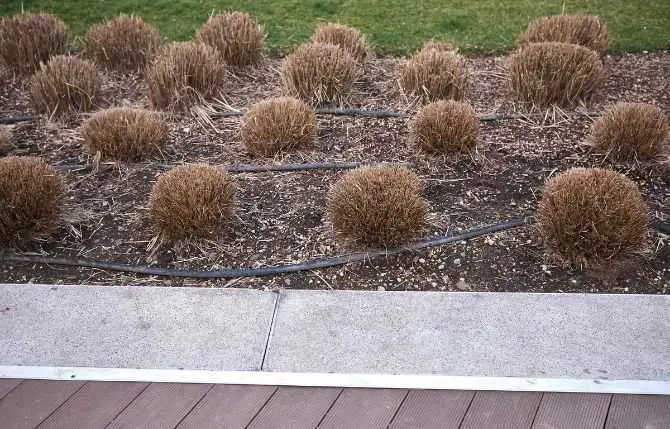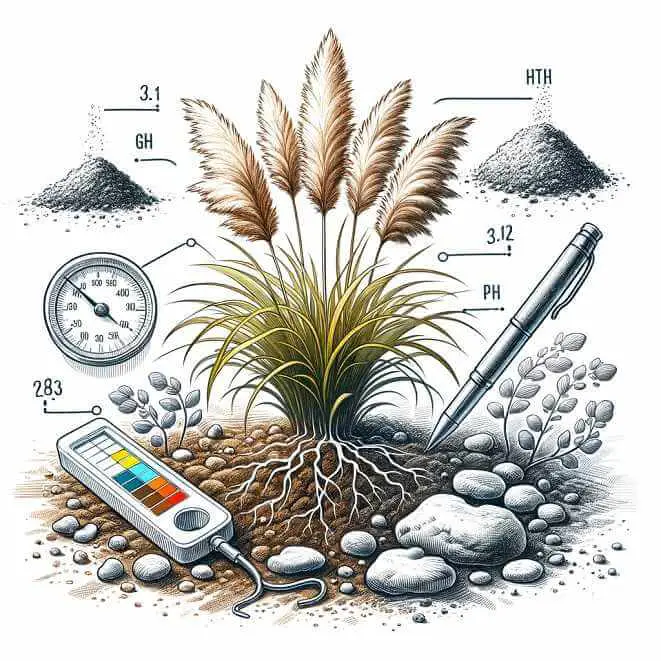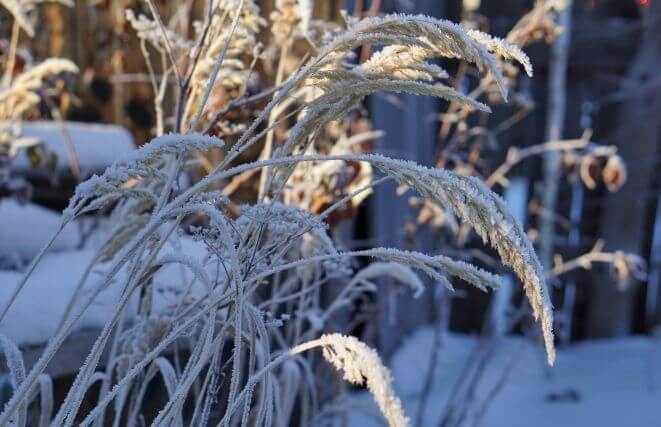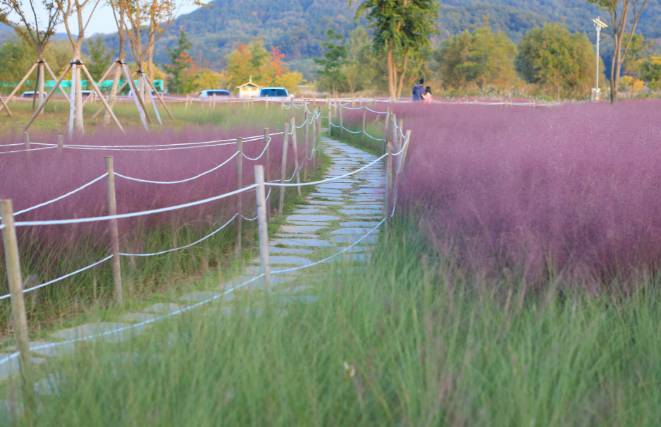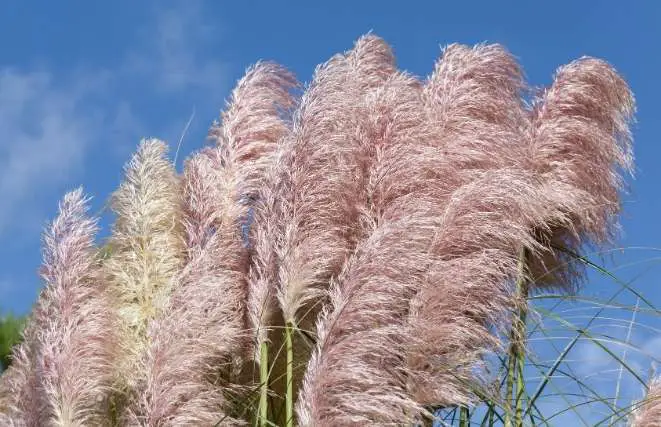Pampas grass is the king of ornamental grasses. You can’t go on Instagram without seeing someone use the plant to make a decoration of some sort. That’s probably inspired you to get some pampas grass yourself.
In this post, we’ll cover everything you need to know about pruning pampas grass, including when and how to do it, tools and safety tips, and common mistakes to avoid
Pampas Grass – Cortaderia Selloana
Pampas grass, or Cortaderia selloana, is an evergreen grass that typically blooms during summer and autumn. It is an oriental grass that is capable of reaching upwards of 10 feet tall, making it ideal for larger gardens.
In particular, pampas has grown in popularity thanks to the contributions of interior decoration social media accounts. The plant has this unique feather-like property that works well with a number of different decor pieces, which has driven more and more people to use it.
However, growing pampas isn’t like growing daffodils. This plant requires serious care, and you need to know what you’re doing.
This isn’t just because of how tall the plant can grow, but the fact that it’s actually an invasive species. It’s a weed that is capable of growing remarkably quickly. It takes up soil space from other plants and trees, ultimately crowding them out.
The effects of pampas in this capacity are so great that it is actually outlawed in a lot of different areas. That’s not to say you’re going to prison for owning some, but it does mean that it is particularly difficult to find somewhere to buy it.
It’s not impossible to get your hands on, though, especially if you’re growing it yourself. Just make sure that you remember the fact that, no matter how nice it looks, it is a weed.
When you plant it, keep it in a soil patch that is completely isolated from the rest of your garden. Otherwise, you’re going to have a major problem on your hands.
How to Prune Pampas Grass
To prune pampas grass, Cortaderia selloana, you’re going to have to make use of a few tools. These tools are going to help you cut the plumes on the oriental grass and allows you to make sure your pruning goes smoothly.
Before you get started
You have to know that the old foliage you’re going to be cutting through is razor-sharp. Unless you’re wearing the right clothing, you risk getting cut.
You’re going to want to wear:
- Though leather gloves.
- Long-sleeved shirt or jacket.
- Full-length trousers.
- Tough boots.
Once you’re taken care of what clothes you have to use, you should start worrying about your tools. Cutting pampas grass, whether you’re pruning tall foliage or just giving the leaves a trim, requires more specialized equipment than you might be used to.
You can’t use your hedge sheers here. Instead, you should try to use a sharp electric chainsaw or power hedge trimmers.
The reason you require such heavy-duty tools is because of how tall the leaves and plumes on pampas grass can grow. The foliage of this plant can reach an average height of 10 feet. Combine that with how tough the plant is, and you’re not going to be able to cut it with anything less than sharp power tools.
So, once you have your clothes and your tools ready to go, you can start the pruning process.
Before you start to cut, you may want to poke around the foliage with a stick. The plumes on pampas grass tend to make great areas for small mammals to nest during the winter. Poke around the ground a few times to scare anything that might be in there away.
Easy to carry and load up with no mess
To make trimming and cleanup easier, first bind the old leaves together with string, Duct Tape, or Bungee cords. You’re going to want to cut away at the leaves near the base of the foliage. You should be trying to leave a tuft that’s about eight inches.
With that done, all you need to do is cut away. Make sure you take care whenever you use your tools. This equipment is going to be sharp and spring-loaded, so you could seriously injure yourself if you don’t take the necessary precautions.
Once you’re finished trimming the plant, you have two options. You can burn off the remaining stubs if you don’t want to have the plant rearing its leaves again any time soon, or you can spread fertilizer around the area to encourage even stronger growth.
The 3 Best Hedge Trimmers to Cut Pampas Grass
If you’re looking to start pruning the old foliage on your Cortaderia Selloana, then you’re going to need the best electric hedge trimmers that you can get your hands on.
Pruning pampas grass, whether you’re doing it in late winter or early spring, is a bit of a nightmare. You have to put your back into it, and it takes a long time.
You may be the best gardener in the world, but you’re not going to cover any ground unless you’re using a power cutter.
To save you all the hassle of doing that shopping yourself, though, I’ve got three different recommendations for the best hedge trimmers to cut pampas grass, each at a different price point.
Best Budget Shears – Dragro Electric Pruning Shears
These electric shears are going to run you less than $130, making it the best budget option I’ve come across. It’s not overly large, but it shouldn’t struggle with pruning your plants, including pampas grass.
It’s also lightweight and cordless, making it great for pruning in those hard-to-reach places. There’s no wire to get in the way, and you don’t have to be particularly strong to use it.
That being said, the Kimo isn’t going to suit you if you have a large garden that requires constant maintenance and attention. It’s going to get the job done with pampas, but it struggles with prolonged use.
If you’re a regular gardener in need of a trimmer that’s going to be a Jack of all trades, then this isn’t it. However, if you’re looking for shears that are going to get the job done in a hassle-free way for a good price, then this should be your pick.
Best Bang for Your Buck – Black Decker 40v
The Black Decker 40v is only slightly more expensive than the Kimo, and yet it’s almost twice as powerful. It’s cordless shears that are going to help you chop down any of those large plants that have been running rampant in your garden.
It’s a phenomenal piece of kit that can help you with both your pampas grass, as well as the rest of your plants that could do with some pruning.
That being said, it’s not ideal for any particularly large and long plants. While it can manage with the geet numbers that pampas grass grows to, you might require something more heavy-duty if you’re pruning a wild garden.
Best For Power – Black Decker 60v Max
The Black Decker 60v Max is the 40v, but stronger. Black Decker is known for making some of the best gardening tools around, so it’s no surprise that two of its trimmers end up here.
This piece of hardware is going to cost you almost twice as much as a new Kimo, but you’re getting the performance to justify that price.
No matter what kind of height and growth you’re dealing with, this trimmer is going to be well capable of pruning it for you. It’s got the power to clear your ground and soil in a matter of minutes, keeping your garden looking good as new and ready to grow more plants.
Just make sure that no matter which model you go with, you’re wearing the proper equipment. You’re dealing with sharp blades, sharp blades that are moving at an incredibly rapid pace. Make sure you’re staying safe and taking the necessary precautions; otherwise, you may end up injuring yourself.
Common mistakes to avoid when pruning pampas grass
When pruning pampas grass, there are several common mistakes that gardeners make that can harm the plant or even cause injury. Here are some mistakes to avoid:
- Pruning too early in the season: Pruning pampas grass too early in the season can leave the plant vulnerable to cold weather and frost damage.
- Wearing inadequate protective clothing: Pampas grass leaves have sharp edges that can cause cuts and scratches. Wear thick gloves, long-sleeved shirts, and pants when pruning to avoid injury.
- Leaving dead or diseased plant material: It is essential to remove all dead or diseased plant material when pruning pampas grass to prevent the spread of disease and pests.
- Cutting the plant too short: Pampas grass should be pruned to about one-third of its total height. Cutting it too short can damage the plant and prevent it from regrowing properly.
- Not disposing of the cuttings properly: Pampas grass cuttings can be large and difficult to dispose of properly. Make sure to bundle and tie them securely before disposing of them in the trash or compost.
By avoiding these common mistakes, you can ensure a healthy and beautiful pampas grass plant.
Pampas Grass Pruning Alternatives
Pruning pampas grass takes time and is difficult. It’s a long and drawn-out process that is going to leave you with sore feet and muscles no matter how much care you use.
If you don’t fancy dealing with your pampas grass this way, then you have the option of combing out the dead leaves.
As your pampas grass grows, some of the leaves may end up dying and falling off. That’s not new news, but because of how bushy pampas grass gets, those leaves may never make it to the ground or soil. More often than not, the plant keeps its leaves suspended in the foliage. This can make it look even bushier and more unkempt.
If you want to sort this issue out, grab yourself a rake. Take that rake and just start combing through the plant. Keep pulling the rake back to you as you use it. This is the best way to make sure you’re pulling out all of that dead plant matter.
This isn’t going to help you cut back on how long the height of your pampas grass is, but it may help as a way to keep it looking organized around your garden.
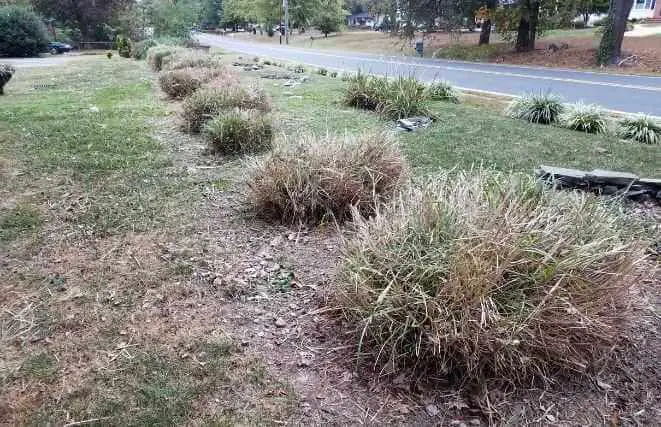
When is the Best Time to Trim Pampas Grass?
The best time to cut back pampas grass is in the late fall or early winter. This will allow the plant to rest and store energy for the coming spring. You can also trim it back during the spring months if there are any new shoots coming up from the ground and they are getting too close to the desired height.
If you intend to keep any foliage you trim, it would be best if you did some prep care before using it as decoration.
Hang the foliage upside down in a dark and dry location. You don’t have to do this for too long, just one or two weeks. Spray the plant down with hair spray to make sure the seeds stay attached to it.
Once the plant is dry, you can take it down and use it in any way you want.
If you’re not all that interested in keeping the foliage, then you don’t have to wait until winter or early spring. You can grab your tools any time you want, whether it’s late spring or autumn. As long as you’re taking care to use the tools correctly and you’re wearing safety equipment, you can start trimming your plant whenever you want.
Be aware that cutting your pampas in the winter doesn’t mean it’s automatically going to be fluffy. Instead, it gives you the longest lifespan from the grass. It’s not going to be fluffed up until summer when there is a strong sun.
Why Should I Prune my Pampas Grass?
You have to cut and prune all kinds of plants, from ornamental grasses to flowers. By doing regular pruning and cutting, you’re going to make sure that your plants don’t grow too tall.
This is one of the most basic ways to take care of your plants. Not only is it going to help you keep your plants organized and neat, but it can also be used to encourage new growth. Your pampas grass can end up growing back stronger if you put effort into your pruning, which is just one of the advantages of doing it.
However, another particularly important reason to consider when trimming your plant is how invasive the species is. Pampas grass, Cortaderia Selloana, is among the ornamental grasses that are considered invasive plants. Pampas grass has a fast growth rate, and it takes up the space of other plants and flowers, suffocating them.
The effects of pampas grass are so severe that it’s actually illegal to own it in a number of states. While that doesn’t stop most people from using it personally, and it’s not an overly enforced law, it does prevent people from planting pampas grass anywhere that it could cause an issue for flowers or other plants.
Therefore, if you plan on growing some new plants, then pruning and making the decision to cut back your pampas grass foliage may be a good option before you start.
What are the Signs that your pampas grass needs pruning?
Here are some signs that your pampas grass may need pruning:
- The grass looks overgrown and untidy
- The center of the plant is turning brown or dead-looking
- The leaves and plumes are bending or breaking under their weight
- The plant is taking up too much space in your yard or garden
- The grass is obstructing walkways or blocking views
If you notice any of these signs, it may be time to consider pruning
your pampas grass.
Pruning Pampas Grass FAQ
If you don’t prune pampas grass, it will become overgrown and develop a large, dense clump that may be unsightly or take up too much space. The grass may also start to shed its leaves and become less attractive. Additionally, if left unpruned, pampas grass may become a fire hazard, as the dry foliage can ignite easily. Overgrown pampas grass may also start to bend over and block walkways or obstruct views. Therefore, it is important to prune pampas grass regularly to keep it healthy and attractive.
Unlike a lot of other ornamental grasses, pampas grass has this unique feathery look to it that makes it such an attractive decoration.
I’ve already talked about how to get it fluffy while pruning, which is to say wait until late winter or early spring to cut it, but what if your pampas grass is already out of the ground?
The answer to this is pretty simple. Take your pampas grass outside on a sunny day. That’s all there is to it. The grass is going to puff up in response to the sunlight, giving you that look that you’re after.
Just be careful when you’re doing this. Despite how tough it is to cut back new growth with pampas grass, the stems are actually quite fragile. When you’re taking it outside, take care not to step them.
No, it is not illegal to cut pampas grass in the UK. However, there are laws in place that prohibit the planting of non-native species that can cause harm to the environment, including pampas grass. It is recommended to check with local authorities before planting or cutting pampas grass.
Wrapping It Up
If you’re looking to cut back or prune pampas grass, you’ve in for a difficult old time. Pruning new growth with pampas is not like it is with other ornamental grasses. Not only are you going to be working in the winter when it’s cold, but you’re going to be trying to cut through a plant that’s far tougher than it has any right to be.
If you want to prune pampas grass and reduce the size, then you should be trying to follow all of the tips and tricks I’ve outlined here. Cutting in the winter is going to let you get the most out of your grass, but you need to make sure you’re looking after yourself.
Pampas grass cuts the skin. Make sure your feet and hands are protected as pampas grass is capable of giving you some nasty cuts. Take your time and use your tools carefully. Staying safe is the most important part of this process. Once you make sure that you’re looked after, cutting down the grass becomes a cakewalk.
Hopefully, you’ve found some of the information I’ve covered in this article helpful. Pampas is a handful to grow, to be sure, but it’s also very beautiful.
The plant has become a social media superstar for a reason. Its unique and feathery look can elevate whatever room you place it in, whether you like it as a background accent of a dominating piece. Therefore, as long as you make sure you’re looking after the plant regularly and not letting it infest your garden, you should be perfectly fine.

